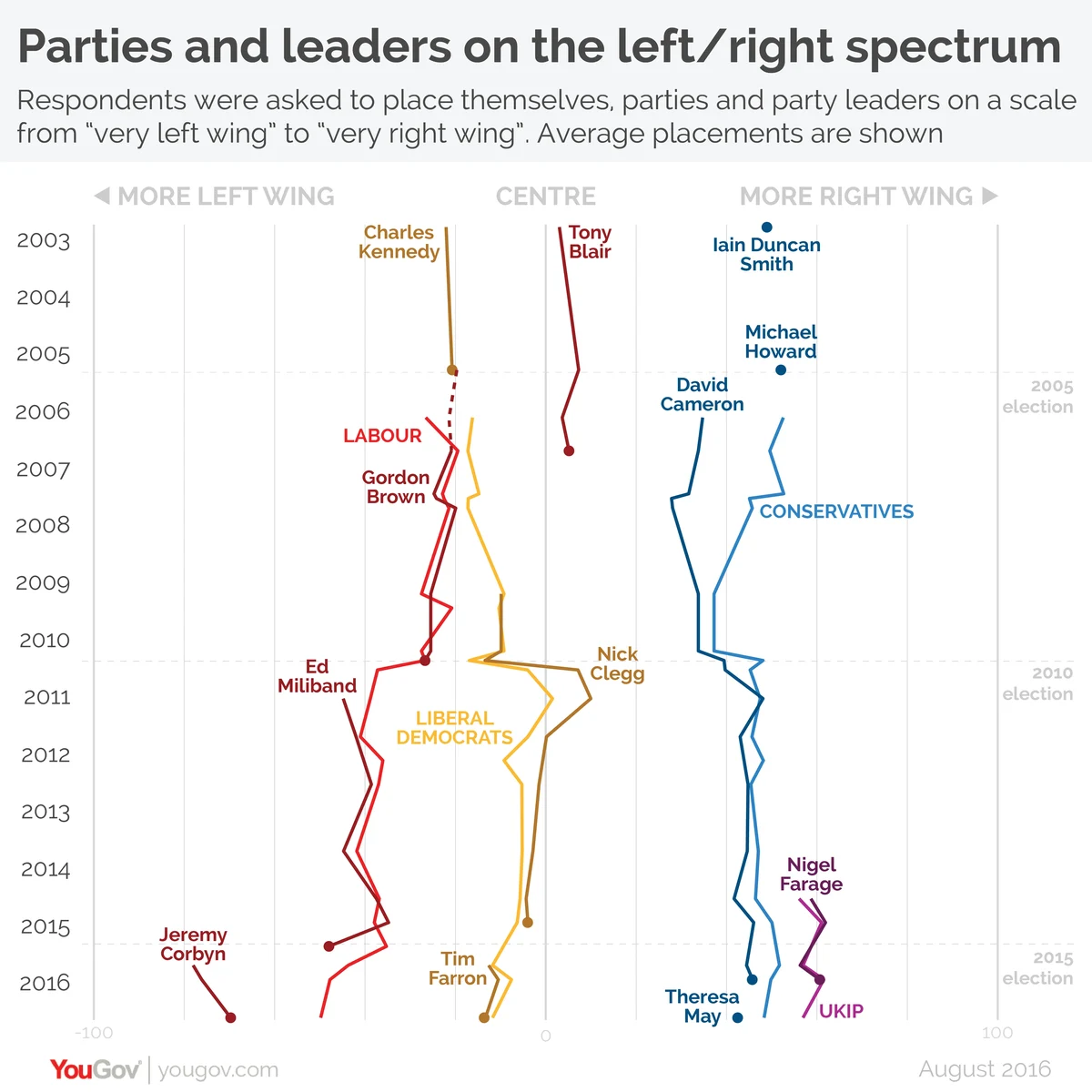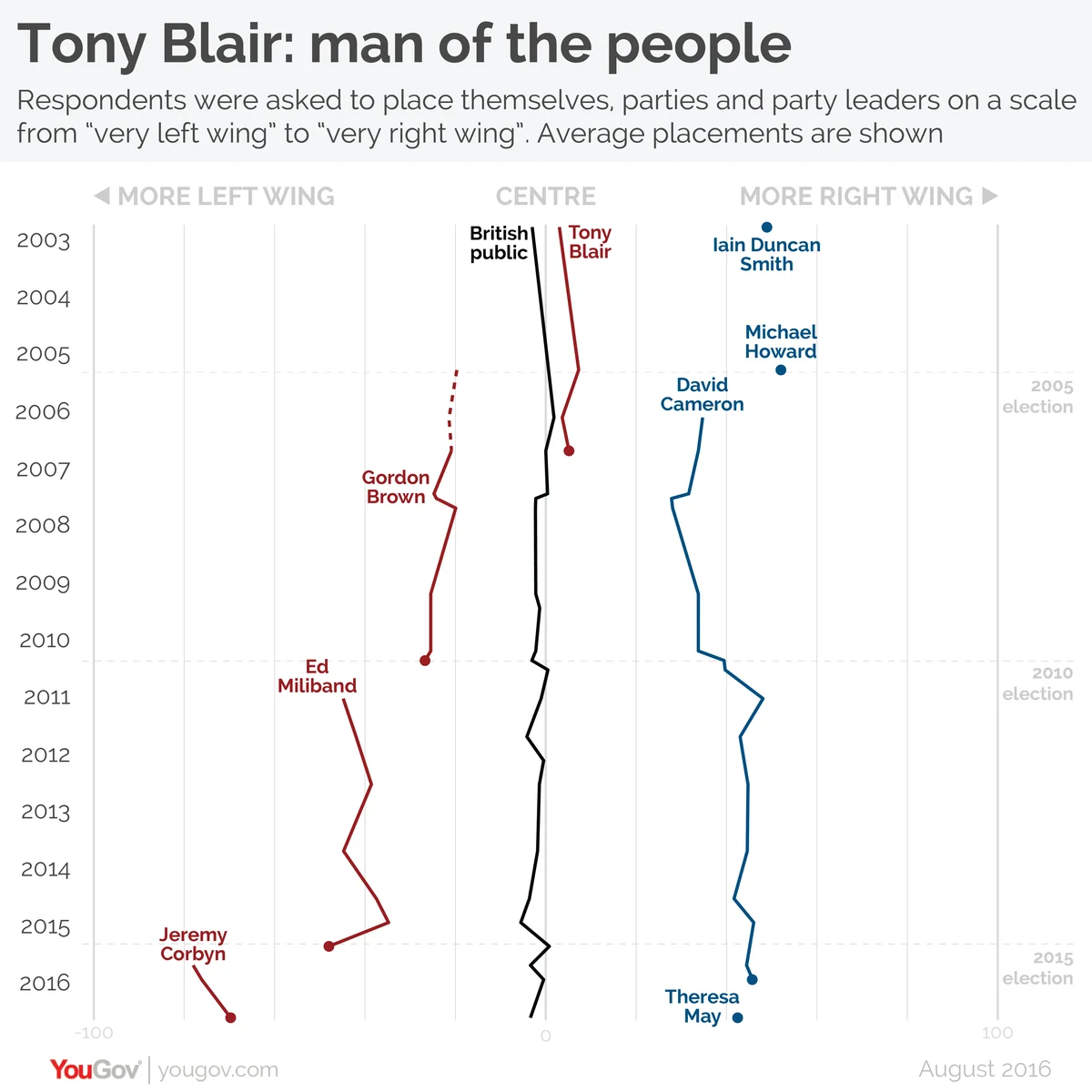Theresa May has set out a new direction for the Conservative party. YouGov data shows how far previous leaders have been able to convince the public that their parties have changed
Theresa May is seen as continuity-Cameron in ideological terms, a new YouGov poll reveals. The new Prime Minister is seen by the public as fractionally less right wing than her predecessor. Compared to her opponent Jeremy Corbyn, however, she is seen as being broadly in line with her party as well as being much closer to the general public.
In 2002, May famously warned that the Conservatives were seen by too many of the British public as "the nasty party". When making her pitch for the Conservative leadership, she set out a series of policies that implied a new direction for the party, with pledges to tackle executive pay, put workers on company boards and develop a new industrial strategy. Now as Prime Minister and leader of the Conservatives, she has an unprecedented opportunity to change public perceptions of her party.
YouGov has been tracking public perceptions of where the political parties and leaders stand on the left-right spectrum since 2002. The results are plotted on a 200 point scale, stretching from -100 (very left wing) to 100 (very right wing). The political centre sits at zero. Combining our data on public perceptions of both leaders and parties for the first time has provided some fascinating comparisons between leaders, and the effect they can have on the way the public sees their parties.
The leadership effect
The data highlights clearly the extent to which party leaders are able to drag perceptions of their party to be more in line with themselves. The most obvious example is David Cameron. When Cameron first became party leader he was seen as significantly to the left of the Conservative party (35 vs 53 respectively). This gap would persist for the next couple of years, but Cameron’s modernisation project finally seemed to have borne fruit by March 2009 when the public began to see the party in less right wing terms (its rating shifting to 37) almost identical to perceptions of Cameron.

This effect is also visible much more immediately with Ed Miliband and Jeremy Corbyn. Public perceptions of the party immediately shifted leftwards towards each leader upon their election to the leadership. There is a similar, albeit more subtle effect with the Lib Dems, who can seen making the ideological journey rightwards to Nick Clegg’s position from the time we started polling the party in 2006 to the time we started polling Clegg as well in 2009. The party would also tack leftwards upon Tim Farron’s election.
There do seem to be limits on the ability of the party leader to change perceptions of their party, however. The effects of Cameron’s modernisation project never survived past the 2010 election campaign, with perceptions of the Conservatives (and Cameron) lurching rightwards in May 2010. By September 2015, the party was seen as exactly as right wing as it had been when Cameron took over. By the end, views on Cameron’s ideology had long since converged with those of his party.
Tony Blair seemed to have the opposite problem. By the end of his time in office Blair had proved unable to defy political gravity, having failed to bring perceptions of the Labour party as close to the political centre as he himself was.
Jeremy Corbyn has had the effect of driving the public’s view of the Labour party leftwards, with the party now standing at -50 on the scale. He still remains far to the left of his party though, sitting some 20 points further to the left on the spectrum than Labour in the public eye, and that is after he himself has shifted eight points rightwards since he took over.
Tony Blair: man of the people
Of all the Labour and Conservative leaders, Tony Blair was the only one to ever come close to the general public – not more than 6 points away over our time period.

By comparison, David Cameron was never seen as less than 30 points to the right of the general public. Brown was seen as slightly closer to the public than Cameron whilst he was Prime Minister, as was Ed Miliband, although they were unable to translate it into electoral support. With a rating of -76 in December last year, Jeremy Corbyn is by far the politician who has been seen as furthest from the public.
Photo: PA
Save










